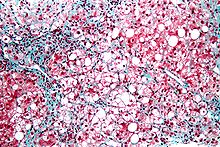Steatohepatitis
| Steatohepatitis | |
|---|---|
 | |
| Micrograph of steatohepatitis. Liver biopsy using trichrome stain | |
| Specialty | Gastroenterology |
Steatohepatitis is a type of fatty liver disease, characterized by inflammation of the liver with concurrent fat accumulation in liver. Mere deposition of fat in the liver is termed steatosis, and together these constitute fatty liver changes.[1]
There are 2 main types of fatty liver disease (FLD):
- Metabolic Dysfunction Associated Steatotic Liver Disease (MASLD) (previously non-alcoholic fatty liver disease or NAFLD)
- Alcohol-associated (Alcohol-related) Liver Disease (ALD)
Risk factors for MASLD include diabetes, obesity and metabolic syndrome. When inflammation is present it is referred to as alcoholic steatohepatitis and nonalcoholic (metabolic dysfunction associated) steatohepatitis (MASH, previously NASH).[2] Steatohepatitis of either cause may progress to cirrhosis, and MASH is now believed to be a frequent cause of unexplained cirrhosis (at least in Western societies). MASH is also associated with lysosomal acid lipase deficiency.[medical citation needed]
The word is from steato-, meaning "fat" and hepatitis, meaning "inflammation of the liver".
Alcoholic steatohepatitis
[edit]Chronic alcohol intake commonly causes steatohepatitis.[1]
Metabolic Dysfunction Associated Steatohepatitis (MASH)
[edit]Previously known as non-alcoholic steatohepatitis (NASH) is fatty liver disease due to causes other than alcohol. No pharmacological treatment has received approval as of 2015 for NASH.[3] Some studies suggest diet, exercise, and antiglycemic drugs may alter the course of the disease. General recommendations include improving metabolic risk factors and reducing alcohol intake.[4][5] NASH was first described in 1980 in a series of patients of the Mayo Clinic.[6] Its relevance and high prevalence were recognized mainly in the 1990s. Some think NASH is a diagnosis of exclusion, and many cases may in fact be due to other causes.[7]
See also
[edit]References
[edit]- ^ a b "Alcoholic Steatohepatitis – Causes, Symptoms And Treatment". Doctor Tipster. 8 July 2011. Retrieved 21 Dec 2016.
- ^ Vuppalanchi R, Chalasani N (January 2009). "Nonalcoholic fatty liver disease and nonalcoholic steatohepatitis: Selected practical issues in their evaluation and management". Hepatology. 49 (1): 306–317. doi:10.1002/hep.22603. PMC 2766096. PMID 19065650.
- ^ Ratziu V, Goodman Z, Sanyal A (April 2015). "Current efforts and trends in the treatment of NASH". Journal of Hepatology. 62 (1 Suppl): S65–S75. doi:10.1016/j.jhep.2015.02.041. PMID 25920092.
- ^ Adams LA, Angulo P (May 2006). "Treatment of non-alcoholic fatty liver disease". Postgraduate Medical Journal. 82 (967): 315–322. doi:10.1136/pgmj.2005.042200. PMC 2563793. PMID 16679470.
- ^ Veena J, Muragundla A, Sidgiddi S, Subramaniam S (December 2014). "Non-alcoholic fatty liver disease: need for a balanced nutritional source". The British Journal of Nutrition. 112 (11): 1858–1872. doi:10.1017/S0007114514002591. PMID 25274101.
- ^ Ludwig J, Viggiano TR, McGill DB, Oh BJ (July 1980). "Nonalcoholic steatohepatitis: Mayo Clinic experiences with a hitherto unnamed disease". Mayo Clinic Proceedings. 55 (7): 434–438. PMID 7382552.
- ^ Cassiman D, Jaeken J (February 2008). "NASH may be trash". Gut. 57 (2): 141–144. doi:10.1136/gut.2007.123240. PMID 18192446. S2CID 206946004.
